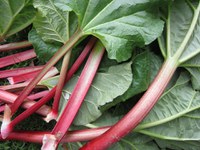Prairie Fare: Be Adventuresome During Rhubarb Season
(Click an image below to view a high-resolution image that can be downloaded)
By Julie Garden-Robinson, Food and Nutrition Specialist
NDSU Extension
“Mom, how did they figure out we could eat rhubarb, anyway?” my older daughter asked me.
I had cut some stalks of rhubarb and was disposing of the large green leaves. A wilted leaf caught her attention and soon she had it draped over her head like a large green scarf. Of course, she snapped a couple selfies to share with her friends.
A friend’s dachshund puppy was at our house, and the curious puppy came close to check out the situation. Soon the puppy was wearing the rhubarb leaf. She trotted around with her green robe like a princess without a crown.
I was amused by this impromptu fashion show as I pondered my daughter’s question.
We don’t always have precise information detailing how or when some foods were discovered to be edible. Usually, animal feeding behavior or adventuresome human ancient feeding behavior guides us. Sometimes the food appears in early artwork or is mentioned in early writings.
Rhubarb has been consumed for thousands of years, dating back to 2700 B.C in China, where it was used as an herbal medicine. In the 1700s, rhubarb was grown in Europe, and it finally reached Maine around 1800, according to some historical accounts.
Unfortunately, during World War I, some people ate rhubarb greens because of the vegetable shortages and became very ill because of the high concentration of oxalates in the greens.
Consuming large amounts of oxalic acid could affect your heart, digestive system and respiratory system, but keep the risk in perspective. According to some sources, a person would need to consume 11 pounds of rhubarb leaves to reach a fatal dose. We have plenty of vegetables available, so dispose of rhubarb leaves.
Rhubarb grows well in cool climates. It even tolerates minus 20 F temperatures during Midwestern winters. However, it doesn’t thrive in most hot, dry regions of the southern U.S.
If you decide to grow rhubarb, you will need to be patient. You shouldn’t pick any rhubarb the first year, but you can harvest your rhubarb crop lightly the second year. By the third year, you can enjoy plenty of rhubarb-based recipes.
Contrary to popular belief, the entire rhubarb plant does not become toxic later in the summer. It may become stringy and tough, though, so the best time to pick rhubarb is during early summer.
To freeze rhubarb to enjoy next winter, choose tender stalks, then wash and cut. You can freeze rhubarb with or without blanching, which is a brief boiling in water. If you blanch for one minute in boiling water, you will have better flavor and color retention. Place the raw or heat-treated rhubarb in containers, leaving one-half inch of head space.
Rhubarb also is known as “pie plant” because it is used in desserts. It provides vitamins A and C, potassium and fiber, but because of its tartness, it requires a fair amount of added sugar.
If you are not sure what to do with all the rhubarb leaves, you can compost them similar to other yard waste. Don’t be worried about the oxalic acid because as the leaves decompose, the oxalic acid breaks down. It does not inhibit the microbial action of composting. You can use the composted material safely in your garden later, but keep kids and pets out of the composting bin for many reasons.
Here’s a change-of-pace rhubarb recipe for those with an adventurous spirit and a love of tasty grilled food. It is courtesy of the “Rhubarb Compendium” (at http://www.rhubarbinfo.com/recipes). The acidity of fruit is a tasty accompaniment to meat and poultry.
Grilled Chicken With Rhubarb Relish
Relish
3 c. diced rhubarb
3/4 c. sugar
1 Tbsp. grated orange zest
1 c. orange juice
1 or 2 jalapeno peppers, seeded and chopped
2 small shallots, minced (you can substitute about 1/4 c. of minced yellow onion)
Place all relish ingredients in a medium saucepan. Bring to a boil, then reduce the heat and simmer, stirring occasionally, for about 10 minutes or until mixture thickens. Cool.
Grilled Chicken
6 boneless, skinless chicken breast halves (about 1 1/2 pounds)
1 Tbsp. fresh lemon juice
1 Tbsp. olive oil
1/4 tsp. each of salt and pepper, or to taste
Preheat the grill. Sprinkle chicken with salt and pepper. Brush with lemon juice and oil. Grill about six minutes per side, until the internal temperature reaches 165 F.
Serve grilled chicken with rhubarb relish.
Makes six servings. Each serving has 280 calories, 5 grams (g) fat, 27 g protein, 29 g carbohydrate, 1 g fiber and 150 milligrams sodium.
(Julie Garden-Robinson, Ph.D., R.D., L.R.D., is a North Dakota State University Extension food and nutrition specialist and professor in the Department of Health, Nutrition and Exercise Sciences. Follow her on Twitter @jgardenrobinson)
NDSU Agriculture Communication - May 31, 2018
| Source: | Julie Garden-Robinson, 701-231-7187, julie.garden-robinson@ndsu.edu |
|---|---|
| Editor: | Ellen Crawford, 701-231-5391, ellen.crawford@ndsu.edu |



